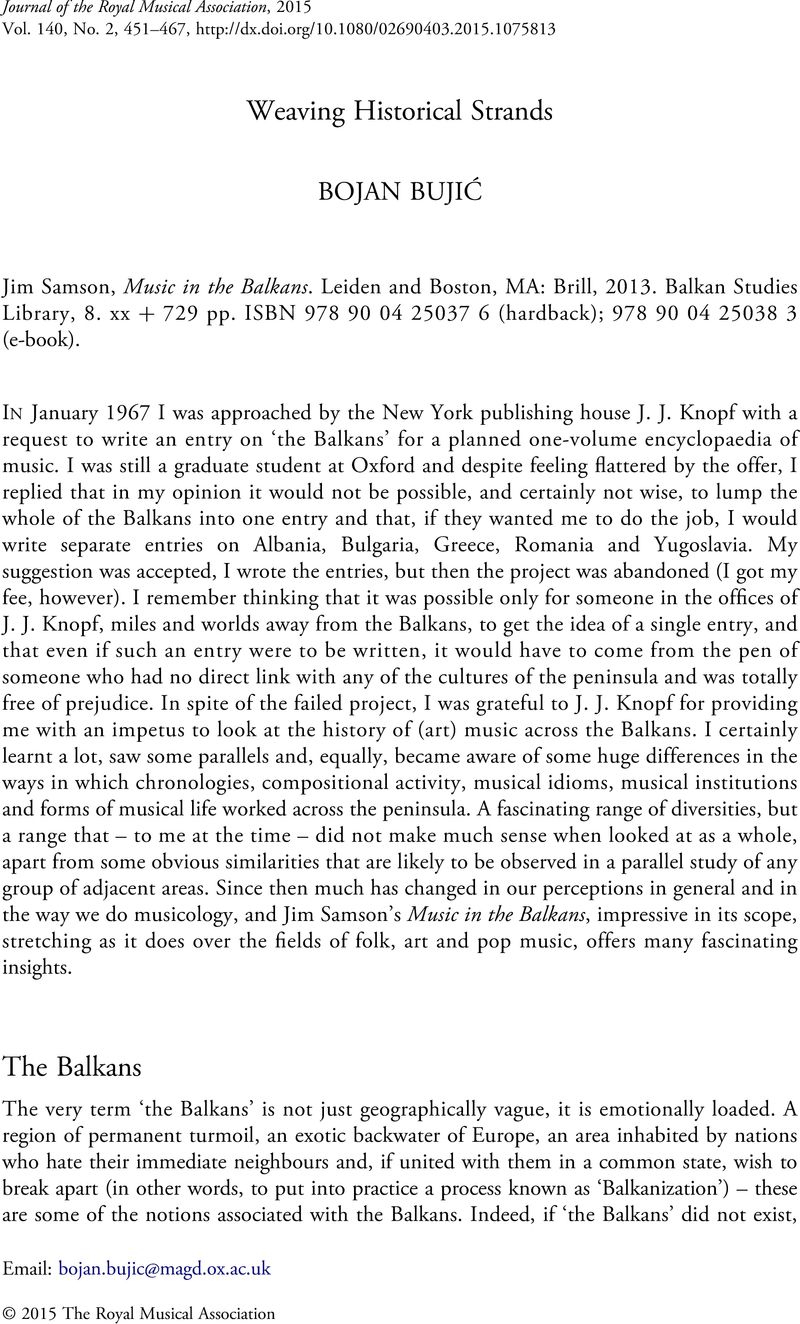Published online by Cambridge University Press: 01 January 2020

1 Johann August Zeune, Gea: Versuch die Erdrinde sowohl im Land- und Seeboden mit Bezug auf Natur und Völkerleben zu schildern (3rd edn, Berlin, 1830), 238. I have been unable to consult the first edition of this work, which has a different subtitle.
2 That it is not easy to be sure about the details of Balkan geography is shown by Jim Samson himself. In a couple of places (see pp. 51 and 84) he says that the province of Vojvodina, now in northern Serbia, is a part of the Banat, when in fact the opposite is true: Banat (along with Bačka and Srem) is a part of Vojvodina. Further minor quibbles are: Istria is not a part of Dalmatia (p. 189) and is not even contiguous with it; and Porto Re (p. 418), which is the Italian name for Kraljevica, is not in Istria but further east, on the Croatian Littoral.
3 Oxford English Dictionary, ‘Balkan’, section B.2, <http://www.oed.com/view/Entry/14891?redirectedFrom=Balkan#eid> (accessed 25 September 2014).
4 He had already outlined his programme and the main themes of his projected study in Jim Samson, ‘Borders and Bridges: Preliminary Thoughts on Balkan Music’, Musicology, 5, (2005), 37–55. Another account, closely following the themes of the book, has been published as Samson, ‘Little Stories from the Balkans: Four Case Studies’, Music of Transition: Essays in Honour of Eva Sedak, ed. Nikša Gligo, Dalibor Davidović and Nada Bezić (Zagreb, 2009), 268–75.
5 See, for instance, the entries on ‘Courtois, Lambert’, ‘Cecchino, Tomaso’ and ‘Lukačić, Ivan’ in The New Grove Dictionary of Music and Musicians (2nd edn, Oxford, 2001), and the online version available at <http://www.oxfordmusiconline.com>.
6 See Philip Bohlman, ‘La riscoperta del Mediterraneo nella musica ebraica: Il discorso dell’ “altro” nell'etnomusicologia dell'Europa’, Antropologia della musica e culture mediterranee, ed. Tullia Magrini, (Bologna, 1993), 107–24.
7 Henry Fanshawe Tozer, Researches in the Highlands of Turkey, 2 vols. (London, 1869), i, 236.
8 Theodor W. Adorno, Introduction to the Sociology of Music, trans. E. B. Ashton (New York, 1976), 164.
9 Garth Cartwright, ‘Romanian Fiddlers, Bulgarian Balladeers – Meet the Eastern Europeans who are Bringing their Distinctive Sounds to our Shores’, The Sunday Times Culture Magazine, 26 January 2014, 22.
10 For a detailed account of these works, see Iva Nenić, ‘Inner/Outer Borderland: Contemporary “Reworking” of Gusle’, New Sound: International Magazine for Music, 38 (2012), 17–28, available at <http://www.newsound.org.rs/en/pdfs/ns38/New_Sound_38.17-28.pdf> (accessed 28 July 2014).
11 In the revised edition of The New Grove Dictionary (2001) and in the online version, a better balance has been established between art- and folk-music sections in the cases of Slovenia, and, to an extent, Greece, though all other entries still retain a strong bias towards folk music. Confusingly, even the online version still retains an entry on ‘Yugoslavia’, although the ‘rump Yugoslavia’, a short-lived federation of Serbia and Montenegro, established in 1992, was dissolved in 2006. See the relevant entries in The New Grove Dictionary of Music and Musicians (2nd edn) and the online version available at <http://www.oxfordmusiconline.com>.
12 For a review (by me) see Music and Letters, 58 (1977), 232–4.
13 Zenit, 6/38 (1 February 1926), 21. Translations throughout this review article are my own unless otherwise stated.
14 Even Ludwig Strecker, of his publishers, Schott, urged him against ‘folklorism’, first in 1927 and again in 1931. Melita Milin, ‘The Correspondence between Josip Slavenski and Ludwig Strecker’, Musikgeschichte in Mittel- und Osteuropa, Mitteilungen der Internationalen Arbeitsgemeinschaft an der Universität Leipzig, 10 (Leipzig, 2005), 178–85, available at <http://www.gko.uni-leipzig.de/fileadmin/user_upload/musikwissenschaft/institut/arbeitsgemeinschaft/musikerbriefe/1_1_MilinEinl.pdf> (accessed 29 September 2014). Strecker's letters to Slavenski are available at <http://www.gko.uni-leipzig.de/fileadmin/user_upload/musikwissenschaft/institut/arbeitsgemeinschaft/musikerbriefe/1_3_MilinEd.pdf>. This is part of an extensive project at the University of Leipzig on the correspondence between musicians in Central and Eastern Europe: <http://www.gko.uni-leipzig.de/musikwissenschaft/forschung/arbeitsgemeinschaft-fuer-mittel-und-osteuropaeische-musikgeschichte/musikerbriefe.html>.
15 Blagoje Bersa, Dnevnik i uspomene (Diary and Recollections), ed. Eva Sedak and Nada Bezić (Zagreb, 2010), 321. Bersa's diary contains a fascinating wealth of information, though Samson seems not to have been aware of it (it was published well before the closing date for Samson's bibliography, which includes items published as recently as 2012).
16 I base this statement on personal experience. Soon after arriving in Berlin, both Miroslav Spiller (1906–82) and Leo Weiss (1905–28) transferred from Schreker's to Schoenberg's class. I certainly benefited from this transfer: Spiller was my undergraduate teacher of harmony, analysis and orchestration.
17 Miroslav Krleža, ‘Predgovor podravskim motivima’ (‘Foreword to the Motifs from the Drava Valley’), Eseji, 4 vols., Sabrana djela (Collected Works), 18–21 (Zagreb, 1961–3), iii (1963), 295–339 (p. 316).
18 Samson himself says so on p. 367 (see above, pp. 461–2), and these two statements sit uneasily side by side.
19 Mladen Tarbuk, ‘Nikša Gligo i Nova Glazba’ (‘Nikša Gligo and the New Music’), Nova nepoznata glazba: Svečani zbornik za Nikšu Gliga (New Unknown Music: Essays in Honour of Nikša Gligo), ed. Dalibor Davidović and Nada Bezić (Zagreb, 2012), 123–8 (p. 127).
20 This emerged very pointedly in the anti-modernist stances taken by John Adams and Eric Whitacre in the programme The Sound and the Fury: A Century of Music, shown on BBC Channel 4, 12 February 2013, 9.00 p.m.
21 Samson repeats the claim, made by some Slovenian musicologists, that Marij Kogoj was the only Yugoslav who studied with Schoenberg (p. 360). In fact, Kogoj's name is nowhere to be found among the otherwise careful records Schoenberg kept of his pupils, and the only recorded Yugoslav students of Schoenberg were M. Spiller and L. Weiss (see above, note 16).